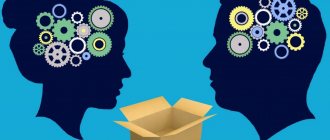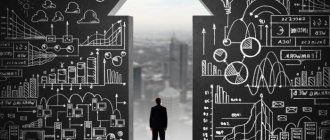Thinking what it is
Thinking is the highest level of human consciousness, allowing a person to navigate the world around him, accumulate experience, and form an idea of objects and phenomena. It is an internal system capable of modeling the patterns of the world around a person, predicting possible developments of events, analyzing what is happening and accumulating unique truths.
Main functions: setting a goal and planning its achievement, finding a way out of various situations, monitoring what is happening and assessing the degree of achievement of set goals based on personal motivation. In psychology, there are different types of thinking, both healthy and pathological.
System: unity of all aspects
To assess the connection of thinking with language and speech, one should consider these phenomena as a single system. Scientists have long assessed them as inextricable components. There are two points of view that allow us to evaluate and evaluate this system. Genetic involves considering language as a phenomenon that is inextricably linked with formation, the moment of the appearance of the thought process. The second option is functional. This approach assumes the unity of thought and language. Therefore, by default, the mutual existence of these two phenomena is assumed. Such a system is being developed in parallel.
At the same time, scientists do not consider language as an object equivalent to thought, or vice versa. Scientific calculations related to these phenomena and their inherent common features are determined by the idea of the development of thinking. Language and thought have their own unique laws according to which these phenomena develop, as well as specific nuances of functioning. Language is a closed system, and so is thought. The content of these systems varies. It is impossible to define the world around as a clear connection between thought and word - this is confirmed by the differences between different languages and the peculiarities of speech reproduction of a specific thought.
Forms
In psychology, the main forms of thinking are distinguished, including concept, judgment and inference:
- The concept forms a person’s idea of surrounding phenomena and objects; this form is inherent only in verbal speech and allows one to combine objects and phenomena according to some characteristics. Concepts are divided into concrete (true meanings of an object or phenomenon “house”, “child”) and relative (depending on the perception of different people, for example, what good and evil are). The content of existing concepts is revealed in speech through judgments.
- Judgment - refers to a form that represents a denial or statement about the world around us or a certain object. The formation of judgments is possible in two ways: the perception of concepts that are closely interrelated or obtained in the form of an inference.
- Inference represents the formation of a new judgment based on two or more existing ones initially. Any conclusion is formed as a chain of well-founded ideas. The ability to make inferences depends on the stage of development of thinking; the higher it is, the easier it is for a person to find a solution to a certain problem.
All inferences are divided into inductive and deductive. In the first case, the judgment moves from a single concept to a general one, and deductive, on the basis of existing general ones, a whole group of phenomena or judgments is generalized into one general one.
Methods of thinking involve different levels, where at each stage certain goals are achieved: collection of information, analysis of available data and inference as a guide to action or inaction.
How to understand the difference between words and images?
We were all taught to read in approximately the same way: first we memorized letters, then we were taught to form syllables, then words and, finally, to read sentences. This is a standard elementary school technique that influences how we learn to read. The hidden side of this process is that many begin to identify what is written with the image that is formed in the head (this relates to the field of neurolinguistics).
The secret of people who read quickly is that their peripheral vision is better developed, they concentrate less on the level of signs and letters, and they also do not pronounce the word in their head, they do not have subvocalization. They immediately mentally recognize the image.
Peter Kamp, in his book “Speed Reading,” uses one of the techniques for recognizing information, thereby changing the paradigm of information perception that was taught to us in elementary school. Thus, by developing a new skill, you can understand what scientists are talking about when they say that words and images in the head are different things (by the way, you can learn about this in more detail in our speed reading course).
Processes
The thinking process is a purposeful process of operating with concepts and judgments to obtain a result. The process is preceded by a certain situation (which by default will be the condition of the task), followed by the collection of information and its analysis.
At the end of the chain, a person comes to a conclusion, which involves solving a given problem and finding a way out of the current situation or predicting various options for the development of events.
There are only 4 stages of the process aimed at finding a solution:
- Preparation;
- finding a solution;
- inspiration to achieve it;
- checking the results.
The whole process consists of a chain of points flowing from each other.
The process begins with motivation, characterized by the desire to find a solution. This is followed by the collection of information (initial data), their evaluation and conclusion.
Thinking techniques:
- analysis is a mental “sorting out”. Analysis represents the decomposition of a problem into its components and the isolation of its fundamentals;
- synthesis is the process of combining parts into a single whole according to certain characteristics. The relationship of each component to the whole is mentally established. Synthesis is the opposite of analysis and is represented by the generalization of existing details into a single whole;
- comparison is the process of identifying the similarities between objects and phenomena and their differences;
- classification represents a breakdown point by point, forming certain classes and subclasses;
- generalization is the identification of what is common among various objects or phenomena and the identification of what is identified into one group. A generalization can be simple (based on one sign or property) or complex based on different components;
- specification allows you to determine the essence of a phenomenon or object;
- abstraction is the opposite of concretization, when an abstract image is created during the process. The development of abstract perception is influenced by exercises that require a creative approach.
Methods for developing thinking are known to psychologists, neurologists and teachers. Techniques include problem solving, games, learning to look from different angles, training imaginative and intuitive thinking through creativity. In development, it is important to take into account individual characteristics of thinking.
A person with a pronounced tendency towards fantasy should pay more attention to the development of a creative and extraordinary approach in the process of processing information. On the contrary, if you have accuracy and consistency, you should pay more attention in this direction.
The nature of speech
Speech is a structure used by man since time immemorial. In this regard, there is no clear answer to the question of whether the human ability to speak is innate, or whether speech is an acquired skill for everyone. There are different approaches to this issue, taking one side or the other.
For example, people who grew up without interaction with society cannot master any human language, which would seem to indicate that speech is an acquired skill.
At the same time, there are facts that suggest that speech is an innate ability. The baby is able to recognize the sound of human speech among many other similar sounds. Another interesting phenomenon is that in all children the development of speech skills occurs according to the same pattern, which partly also speaks of certain innate abilities for speech.
There are many hypotheses suggesting the origin of speech. Below are some of them:
- Learning Theory;
- Chomsky's theory of specific inclinations;
- Piaget's cognitive theory;
- Psycholinguistic theory of speech development.
Learning theory
Learning theory suggests that from birth a child is inclined to imitate. He first imitates sounds, then words, and then clumsily constructs his first sentences. His first words usually play the role of sentences that briefly describe his desires and motives, an excellent example here would be the word “am” used by kids, which can simultaneously mean both his desire to snack and what he is eating at the moment.
The child receives positive reinforcement from the parents after pronouncing the first sounds and then words, partly this helps him learn new words and grammatical structures and remember them. But what is surprising is that at the stage of sentence formation, parents usually encourage more competent logical conclusions and inventions, and not the correctness of grammatical structures as such. Contrary to this, the child also learns grammatical rules. Also, this theory does not take into account the child’s ability to form words and the child’s very rapid acquisition of speech at a certain period of his life, as well as the need to have inclinations for the development of any skill.
Chomsky's theory of specific inclinations
This theory assumes that a newborn person already has certain abilities to develop speech as such, which are normally formed by the age of one year. From this moment on, the child is very sensitive to the perception of speech, and this period continues until about three years of age, which generally theoretically explains why people removed from human society for a long time in childhood are not able to master any language. At the same time, this is the period of development and formation of speech, while the process of thinking continues to develop in a person until he matures.
Piaget's cognitive theory
According to this theory, a child from birth is inherent in the function of perception and some processing of information. That is, a child is born with a mentality that develops over time. This theory helps explain why a child can make up his own words. Another interesting fact that indirectly confirms this theory is that children at the beginning of speech development speak only about what they already understand.
Psycholinguistic theory of speech development
This theory suggests that speech arises through an endless cycle of thinking and speaking, during which gradual improvement of both occurs. Speech for thinking acts as a kind of symbols that allow you to “dress” thought for its formation, at the same time, with the improvement of thinking ability, it is necessary to expand vocabulary and speech, which also leads to its development.
Disorders
Thought disorders are disorders of mental activity. Violation is divided into quantitative and qualitative.
Quantitative forms of the disorder are characterized by speech impairment, delayed neuropsychological development, or mental retardation.
Forms of quantitative disorder:
- Mental retardation (MDD) is diagnosed in children 2-3 years old. Treatment is prescribed by a neurologist.
- Oligophrenia (mental retardation is characterized by impaired development of a child from an early age). A child with oligophrenia is observed by a neurologist and psychotherapist. The goal of treatment will be socialization and learning self-care.
- Dementia is a disorder of mental processes that manifests itself in adulthood or adolescence. Observation by a psychotherapist.
The speed of thinking depends on the predominance of processes in the cerebral cortex. This may be excessive excitement or, on the contrary, inhibition of mental activity:
- Disruption is characterized by a rapid change of thought, in which speech becomes absurd, logic and consistency of judgments are completely absent. Speech consists of fragments of phrases quickly replacing each other. The grammar of speech is usually preserved. This disorder is inherent in schizophrenia.
- Manic syndrome is characterized by accelerated speech and a simultaneous increase in psycho-emotional background. Speech is accelerated, the patient can speak “excitedly”, especially pronounced in certain topics.
- Slowing down of mental processes is inherent in depressive syndrome. Distinctive features: absence of thoughts in the head, slow speech taking into account the slightest details that are not related to the essence of the issue, predominance of a depressed mood.
- Thoroughness is expressed in excessive “drowning” in details. The patient has difficulty switching from one question to another, and rigidity of thinking is observed. Circumstances are inherent in diseases of the nervous system (Epilepsy).
- Reasoning is revealed during long-term communication and is expressed by a tendency to teach. When a person does not answer the question posed, but talks about things that have nothing to do with him and strives to teach life to everyone with whom he begins to communicate.
- Autism develops in withdrawn people. A distinctive feature of this disorder will be isolation from the world, poor orientation in society and immersion in internal experiences, which often do not correspond to the real state of affairs.
- Obsessive syndrome is characterized by obsession with ideas or thoughts that the patient cannot get rid of, although he understands the absurdity. Obsessive thoughts depress a person, cause negative emotions, make them suffer, but the patient cannot cope with them. They arise against the background of persistent excitation of a part of the nervous system.
- Phobias (unreasonable fear) . Various phobias arise against the background of overexertion and performing a difficult task for an adult or child. In childhood, fear of punishment gives rise to various phobias.
- Extremely valuable ideas arise in adolescence. The predominance of a brightly colored emotional background indicates the development of this syndrome. This disturbance of consciousness does not cause suffering to the patient.
- Delusional thinking (often accompanied by hallucinosis) is characterized by the emergence of persistent thoughts of ideas that cannot be convinced. Inference is based on a logical conclusion made on the basis of some data. This could be fear of persecution, unreasonable jealousy, self-flagellation. Delusional thinking can be dangerous for others and the patient with a pronounced syndrome. Treatment by a psychotherapist or psychiatrist is required.
Pathology of thinking often provokes disturbances in the emotional background (depression, euphoria, apathy). Any disturbance in the thought process should be observed by a specialist. If necessary, psychocorrection or drug therapy is carried out. Ignoring the pathology of thinking can lead to persistent mental pathology and cause serious problems for societies or the patient.
Diagnosis of thinking involves determining the type of excitation of brain activity and the characteristics of thought processes. The ability to solve current problems is also taken into account. The development of speech and thinking is closely related and begins at an early age.
When speech development is delayed, mental activity is also impaired. It is important to notice the deviation in time and begin training thinking, using available methods of developing thinking (game, action, training).
Images and experiences
In Vygotsky’s works devoted to the connection between language and thinking, one can find a comparison of the process of creating a new utterance with a cloud, from which sooner or later it begins to rain words
At the same time, the scientist paid attention to the execution of a thought, and not its embodiment in verbal form. Rubinstein, another well-known specialist in the field of psychology, proposed evaluating speech as an option for formulating a thought, and the process is accompanied by the formation
Similar sayings can be seen in the classics of Marxism, who proposed viewing language as a matter that burdens a person. Engels compared it to the curse of humanity. However, from everyday experience a person can conclude: often conscious actions do not require formalization into words. When performing the simplest manipulations, a person does not say them out loud. It is not always possible to sense inner speech.
By studying language, the functions of language and thinking, scientists have come to the conclusion that verbal is not the only form of the thought process available to humans. It belongs to one of the key types, but along with it there is also practical, effective, as well as visual, figurative, technical. The practical, effective is considered the primary option, since this is how a person was first able to successfully go hunting. Only then did figurative, visual thinking appear. In examples, this can be described by remembering a successful hunt, using the image in the future to evaluate the possible benefits of repeating a set of actions. It was only on the basis of these two types that logical verbal thinking was formed. If we draw a parallel example, it can be illustrated as the transfer of information about successful hunting and the benefits obtained through it to a new generation.
Development (exercises for training)
The development of thinking begins at an early age. At birth, the baby does not have the ability to think, but by the age of one year the beginning of thought processes is formed. To develop thinking, knowledge, experience, and memory are necessary. In the process of development, the child accumulates the necessary components through knowledge of the world around him and the simplest thinking begins to manifest itself.
The speed and quality of the formation of thought processes depends on how much attention parents pay to this issue. It is necessary to constantly work with the child to quickly develop and consolidate thinking skills.
The ability to form thoughts encourages self-learning and knowledge. The development of thinking occurs continuously from birth until complete extinction in the process of communication. Activities and learning new things in everyday life are shaped by a person’s subconscious. At each life stage it has its own characteristics:
- For young children, thinking is visual and effective. All processes aimed at performing the simplest tasks (taking a toy, opening a box, bringing something or getting something). The child thinks, acts, develops. This continuous process is learned in everyday life both through play and through the need to achieve certain actions.
- When mastering speech, the child learns to generalize and gradually his thought process goes beyond the visual and effective. Thinking and speech are in close connection; human speech contributes to the development of abstract thinking, the ability to generalize objects and phenomena, and to identify the essence based on acquired knowledge. Speech in adults is the main way of transferring experience and skills, which greatly facilitates learning.
- The expansion of speech allows one to express oneself in words; the child moves more towards figurative and abstract thinking. At this stage, fantasy is formed. Creative abilities develop.
- Schoolchildren learn to operate with knowledge acquired verbally (general education subjects). There is no practical confirmation by experience. This stage teaches you to draw conclusions based on logical connections and accumulated knowledge about objects and phenomena. Various school curriculum methods increase the efficiency and speed of operating with concepts and reaching conclusions in a short time in the presence of insufficient knowledge about a subject or phenomenon.
- Higher grades promote the formation of abstract thinking. Studying and analyzing fiction provokes the development of thinking and imagination.
The older the child gets, the more thinking methods are involved in the daily process. The main means of developing children's thinking is education, including the formation of speech, the study of objects and phenomena through verbal transmission of data and the formation of abstract thinking and imagination based on fiction, creativity (drawing, knitting, embroidery, wood carving).
The stages of development of thinking directly depend on what was learned earlier and the level of intelligence. Usually appropriate for age categories.
In the accumulation of a conceptual base, several levels are distinguished: the higher the level of development, the easier it is for a person to generalize or analyze phenomena (or objects), the easier it is to find a solution to the question:
- The first level is characterized by the ability to generalize simple concepts accumulated by personal experience or learned when presented in verbal form.
- The second phase is marked by the expansion of conceptual thinking.
- The third level is characterized by the ability to give clearer concepts of conditions, identify specific signs and support what has been said with specific examples from life that are suitable for the meaning and conditions of the task.
- The fourth level is the highest level of conceptual thinking, in which the individual has complete knowledge about an object or phenomenon and easily determines its position in the world around him, indicating the relationships and differences.
Important! The higher the level of knowledge of concepts, the clearer the judgment becomes and the easier the conclusion is reached.
Works and their contents: interesting aspects
Considering language as a means of thinking, Vygotsky spent a lot of time observing monkeys. As part of the experiments, it was possible to reveal the fact that the genetic level of origin of the phenomena under consideration is different, and the development processes proceeded independently of one another. Vygotsky established that during periods of historical development the relationship between the thought process and speech changed; there was no constant, stable value. He also noticed that monkeys, similar to humans, show intellectual reactions only in relation to tools, but do not show a connection between communication and reflection. It was possible to identify the phases preceding the formation of intelligence in animals and the ability to communicate out loud.
Based on observations, conclusions were formulated regarding two options for the manifestation of speech in human society. The first, defined by Vygotsky, is communication. The method involves voicing what a person thinks, with the participation of several people in interaction, passing on some information to each other. The second type of speech manifestation is the union of the one who listens with the one who speaks. In this case, the verbal mental form turns into a means of thinking. This division makes it possible to distinguish between external and internal speech formats. In the first case, the thought is reflected by lexical phrases and is subject to the structures of language; in the second case, we are talking about imparting some meaning to a specific thought. Vygotsky, formulating such conclusions, considers the external speech format to begin with the use of words with the gradual use of more and more developed and complex structures. The inner progresses from the whole to some aspect, from thought to a specific word.
Types of thinking
Thinking represents the highest form of human cognitive activity. Thanks to processes occurring at the subconscious and conscious levels, a person forms concepts about the world around him and phenomena. Finds solutions to problems posed by life.
All processes of mental activity are divided depending on goals and variations in worldview. Ways of thinking are different and allow you to find a way out of any situation with different approaches to solving the problem. The main types of human thinking:
Critical thinking
It is used to evaluate the solutions found in the thinking process regarding the possibility of their application in practice. Critical thinking allows you to choose the most correct solution path and evaluate the reality of its implementation.
Positive thinking
Represented by the acceptance of good fortune and goodness. A person with a positive type of thinking perceives everything in rosy tones, always retains faith in the best outcome and the ability to find a way out of any situation.
Abstract thinking
Allows you to renounce the details and look at the situation or problem as a whole. It needs to be developed from an early age. Pronounced abstraction is characterized by quick thinking and a non-standard approach.
A special feature of the ability to abstract is the ability to quickly find the essence in an unfamiliar situation, collecting all the information in a short time. This allows you to find a solution in any situation.
Logical thinking
This is the processing of available information with an emphasis on cause and effect. In logical thinking, a person uses existing knowledge by processing it in a certain sequence.
The result of such thinking will be finding the most correct solution for a specific problem. It allows you to draw conclusions, decide on further tactics and find a solution in a situation that requires quick action.
When there is no time and opportunity to comprehensively study a subject and develop detailed tactics for solving a problem, logical thinking allows you to quickly outline a path to resolution and begin action immediately.
Clip thinking
This is a feature of perception based on the formation of judgments based on short, vivid images taken out of context. People with clip thinking are able to form judgments based on short news clips or news excerpts.
It is characteristic of the modern generation of young people and allows you to quickly find information of interest without delving into the features and details. It is characterized by surface and little information content. The disadvantage of this type will be a decrease in concentration and an inability to comprehensively study the task at hand.
Creative thinking
Allows you to find solutions that are not recognized by society. Deviation from templates and an extraordinary approach are its main features. Thanks to a decision that is different from the expected one, people with creative thinking are at the advantage under equal conditions with people with thinking patterns.
It allows people of the creative profession to create something new and unique, and businessmen to find solutions to seemingly insoluble problems. People with creative thinking often have behavioral deviations in comparison with the general principle.
Visual-figurative thinking
Allows you to quickly get results thanks to instant processing of information based on visual images. The figurative solution is formed mentally and is accessible to people who are able to create visual pictures quite fully.
This type of thinking is not based on practical facts. Trained from childhood by memorizing an object followed by the most complete reconstruction of its description. Visual-figurative thinking and imagination are closely connected and are easily trained in childhood through play and creative activities.
Systems thinking
Allows you to determine connections between disconnected objects and phenomena. All elements are in mutual connection with each other. The ability to recognize and recreate them allows you to project the result at the beginning.
Thanks to a systematic approach, it is possible to identify different directions of development of events and choose the most appropriate one or identify a mistake in actions and find a solution.
A person with systems thinking is able to simplify the solution of a problem, study reality from different points of view and change his beliefs in the process of life.
All this allows you to adapt to a constantly changing environment and get out of any situation with the least losses.
Spatial thinking
Orientation in space is possible thanks to the development of spatial thinking. This is the ability to navigate in place and perceive the environment as a whole, recreating in memory the location of objects relative to each other and the person himself, regardless of the point at which he is located.
It begins to form at the age of 2-3 years and can develop throughout life.
Strategic Thinking
This is the ability of an individual to predict in advance the result of activity in a certain direction (action), not only personal, but also of the opponent. Developed strategic thinking allows you to calculate the enemy’s moves and act proactively, achieving. thereby. high results.
Analytical thinking
This is the ability to obtain the maximum information from the minimum available material by analyzing each component of the data provided. Through logical reasoning, a person predicts different options when considering an issue from several points of view, which allows one to find the most optimal solution.
People with analytical thinking say that they will first think everything through and then do it. The proverb “try on seven times, cut once” is a guide for people with an analytical mind.
Creative thinking
Characterized by the ability to create subjectively new things based on what already exists. In addition to obtaining a phenomenon or object that is different from the original one, creative thinking allows you to collect information in ways that go beyond templates, which allows you to obtain a solution to the problem quickly and efficiently. It belongs to the productive group and develops easily in childhood.
Lateral thinking
Allows you to solve a problem qualitatively by examining an object or phenomena from different sides and from different angles. Lateral thinking uses not only accumulated experience and knowledge, but also intuitive abilities, which sometimes run counter to scientific ideas.
Based on experience and one’s own feelings, a person can not only find a way out of a situation, but also enjoy solving even complex problems. As a rule, people who use lateral thinking choose a creative approach and an extraordinary type of problem solving, which allows them to achieve the best results.
Associative thinking
This is the ability of the brain to create a variety of vivid images associated with an object or phenomenon, which allows you to study the conditions of the problem not only on a conceptual level, but also to connect the emotional and sensory background, form your own attitude to the problem and fill it with various colors.
With developed associative thinking, a person is able to connect various situations that have nothing in common with a specific subject. For example, people can associate certain events in their personal or social life with a particular tune or movie.
Thanks to this, a person is able to find non-standard solutions to a problem and create something qualitatively new based on what already exists.
Divergent and convergent thinking
Divergent is characterized by an individual’s ability to find many solutions given the same initial data. The opposite is convergent - focusing on one option for the development of an event with a complete rejection of the possibility of other options for solving the problem.
The development of divergent thinking allows you to select many options for solving a problem that go beyond the generally accepted ones, and choose the most optimal path of action that can quickly lead to the desired result with the least expenditure of energy and money.
Thinking outside the box
Allows you to find an unusual solution to a problem in any situation. The main value of non-standard thinking is the ability to find a way out of a “no-win situation” when standard methods do not work.
Sanogenic and pathogenic thinking
Sanogenic (healthy) thinking is aimed at healing, while pathogenic thinking, on the contrary, leads to illness due to its destructive influence. The pathogenic type is determined by a person’s tendency to replay a negative situation many times over time, which leads to the emergence of negative emotions (anger, resentment, rage, hopelessness). Persons with a pathogenic type tend to blame themselves for what happened and constantly suffer, replaying a bad situation.
Holders of a sanogenic worldview are able to abstract from negativity and create a comfortable emotional background; they do not depend on stressful situations.
Rational and irrational thinking
Represented by two opposites. The first type is based on strict adherence to logic and has a clear structure, which allows you to find a solution to most life situations.
The second type is characterized by fragmentary judgments in the absence of a clear thought process.
People with irrational thinking jump from one thing to another, allowing their thoughts to move chaotically. A rationally thinking person always thinks everything over carefully and chooses the most logically verified way to solve a problem. Irrationalists, on the other hand, rely on feelings and emotions.
Conceptual thinking
It is formed in school-age children and consists in the formation of certain truths that do not require proof. Conceptual thinking excludes the possibility of considering an object or phenomenon from different angles due to the formation of a certain cliché. It excludes dissent and creativity in solving the problem.
Scientific thinking
Represents the desire to understand the essence of an object or the root cause of a phenomenon. It is characterized by consistency, requires the collection of evidence and is objective in nature. The advantage of scientific thinking is the ability to study the processes of the surrounding world and use the results obtained for the benefit of society or oneself.
Stereotypical thinking
Represented by the tendency to evaluate events and phenomena according to generally accepted standards without involving logic or creativity. It allows one to socialize, but it kills a person’s individuality and makes him not only predictable, but also easily suggestible.
The development of thinking and imagination is the main method of combating stereotyping and developing the ability to independently solve problems and find a way out of situations. Reduces the efficiency of the process due to the inability to act in situations not described in the instructions.
Discoveries of the latest research
Research over the past decade led by linguist Steven Pinker has shown that the dependence of thinking on language is not justified. In his book Language as Instinct, Pinker examines the scientific arguments for both language and thinking, and explains why thinking is the more complex phenomenon.
Using the thinking of inventor Alan Turing, Steven Pinker brings his terminology about “mental code” into cognitive science and argues that language is less universal than thought. Using the example of the English language, Pinker shows that words are less extensive than their meaning, which can often be understood only from context. Therefore, following Turing, he develops the basic steps of the “imaginative theory of thinking”:
- An image (material object), it is stored in the brain.
- Mnemonic tool (occurs with the help of language).
- Processor (reflexes).
Steven Pinker proves that most information (images, abstractions, family connections, logical reasoning) is not expressed in words - it is the result of more complex processes that occur in the brain. He proves that, for example, English, like any other, cannot fully convey the essence of the information that is stored in our head (this relates to the field of psycholinguistics). According to Pinker's interpretation, these images in our heads do not have to look the same as a phrase in any language. For example, newspaper headlines can be ambiguous because there are more concepts than words, and therefore you also need to use logical operations to understand what the article will be about:
- Stud Tires Out - “The stallion is exhausted” or “The stallion’s tires are outside.”
- Drunk Gets Nine Months in Violin Case - “The drunkard was given nine months in the violin case” or “The drunkard was imprisoned for nine months in a violin case.”
- Iraqi Head Seeks Arms - “The head of Iraq is looking for weapons” or “The Iraqi head is looking for hands.”
Therefore, cognitive psychologists and neurophysiologists are now trying to understand what kind of images and processors for processing information are available in the human brain.
Steven Pinker gives his explanation of why, according to many, language prevails over thinking. It all lies in the cognitive distortion of the modern world - the belief that words determine the way of thinking does not take into account many linguistic and semantic features of the meanings of the words themselves, which often need to be clarified. Such an overestimation of the role of language is quite understandable: words and texts are around us, but thoughts are always locked in our heads.
Steven Pinker strengthens his arguments about the possibility of thinking without using language with several examples when thinking does not depend on language:
- Aphasia or deaf children - people with such disorders manage without language, but they also adapt to the world and distinguish between animals, numbers, time, and space in their own way.
- Monkeys and other talking animals are unable to develop language, although they can repeat some words and phrases.
- Many creative people claim that they think not in words, but in mental images.
- Natural scientists argue even more insistently that their thinking is spatial, not verbal.
Pinker's arguments can be supported by the arguments of cognitive scientist Roger Shepard. His research concerns the study of visual and mental imagery, as well as auditory illusions in humans. His scientific conclusions regarding human perception prove that cognition occurs not only with the help of a verbal outline of the world, images and objects, but requires more complex mental influence.
Thus, in recent years, many scientists have moved away from the concept of the interdependence of language and thinking, arguing that thinking is a more complex phenomenon that uses language as one of the sources for obtaining information
Moreover, new scientific questions are already emerging about the importance of visual perception, as well as optical illusion and psychological influence in the process of thinking and information processing









